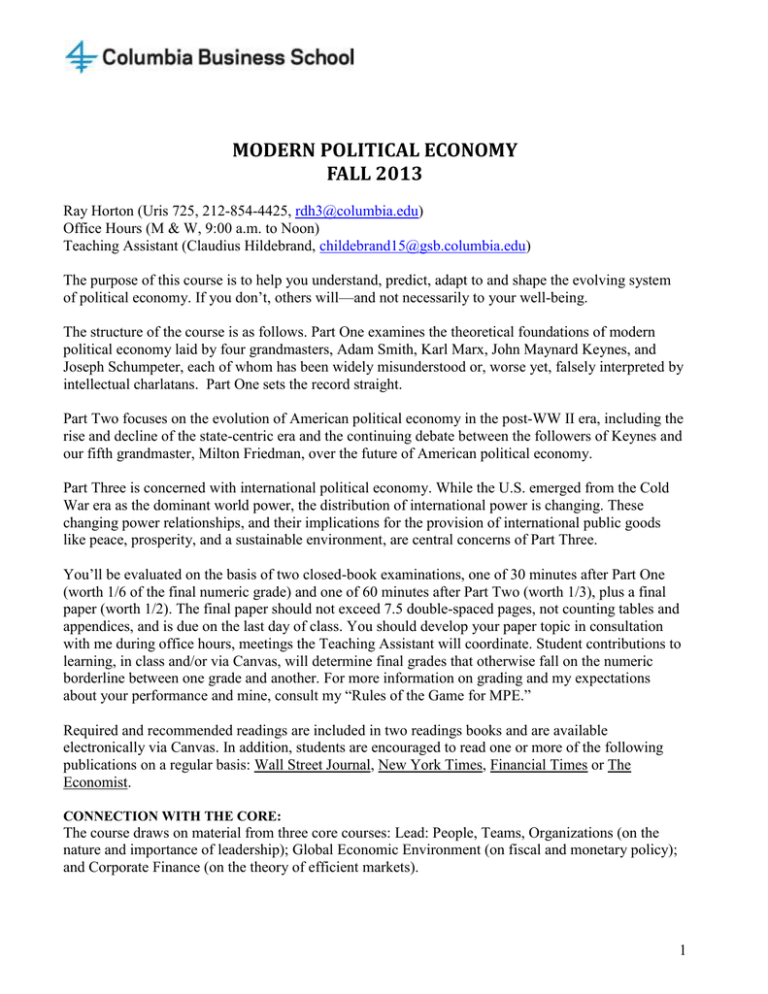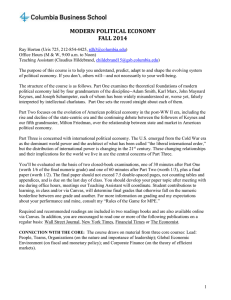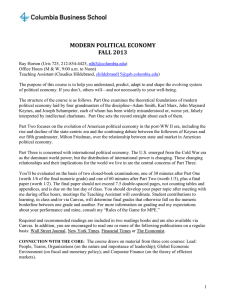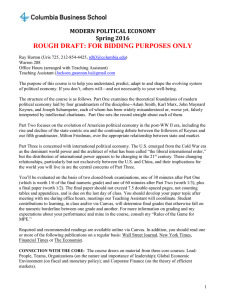MODERN POLITICAL ECONOMY FALL 2013
advertisement

MODERN POLITICAL ECONOMY FALL 2013 Ray Horton (Uris 725, 212-854-4425, rdh3@columbia.edu) Office Hours (M & W, 9:00 a.m. to Noon) Teaching Assistant (Claudius Hildebrand, childebrand15@gsb.columbia.edu) The purpose of this course is to help you understand, predict, adapt to and shape the evolving system of political economy. If you don’t, others will—and not necessarily to your well-being. The structure of the course is as follows. Part One examines the theoretical foundations of modern political economy laid by four grandmasters, Adam Smith, Karl Marx, John Maynard Keynes, and Joseph Schumpeter, each of whom has been widely misunderstood or, worse yet, falsely interpreted by intellectual charlatans. Part One sets the record straight. Part Two focuses on the evolution of American political economy in the post-WW II era, including the rise and decline of the state-centric era and the continuing debate between the followers of Keynes and our fifth grandmaster, Milton Friedman, over the future of American political economy. Part Three is concerned with international political economy. While the U.S. emerged from the Cold War era as the dominant world power, the distribution of international power is changing. These changing power relationships, and their implications for the provision of international public goods like peace, prosperity, and a sustainable environment, are central concerns of Part Three. You’ll be evaluated on the basis of two closed-book examinations, one of 30 minutes after Part One (worth 1/6 of the final numeric grade) and one of 60 minutes after Part Two (worth 1/3), plus a final paper (worth 1/2). The final paper should not exceed 7.5 double-spaced pages, not counting tables and appendices, and is due on the last day of class. You should develop your paper topic in consultation with me during office hours, meetings the Teaching Assistant will coordinate. Student contributions to learning, in class and/or via Canvas, will determine final grades that otherwise fall on the numeric borderline between one grade and another. For more information on grading and my expectations about your performance and mine, consult my “Rules of the Game for MPE.” Required and recommended readings are included in two readings books and are available electronically via Canvas. In addition, students are encouraged to read one or more of the following publications on a regular basis: Wall Street Journal, New York Times, Financial Times or The Economist. CONNECTION WITH THE CORE: The course draws on material from three core courses: Lead: People, Teams, Organizations (on the nature and importance of leadership); Global Economic Environment (on fiscal and monetary policy); and Corporate Finance (on the theory of efficient markets). 1 TOPICS AND READINGS PART ONE THE FIRST FOUR GRANDMASTERS 9/3 & 9/5 Smith’s Theory Required: Adam Smith, An Inquiry into the Nature and Causes of the Wealth of Nations (Indianapolis: Bobbs-Merrill, 1961), Book I, Ch. 1; Book IV, Ch. 2; and Book V, Ch 1. Recommended: Robert L. Heilbroner, The Worldly Philosophers (New York: Simon & Schuster, 1999, 7th ed.), Ch. 3. 9/10 & 9/12 Marx’s Prognosis Required: Karl Marx, Capital (London: Penguin, 1976), Volume 1, Ch. 25; Karl Marx and Friedrich Engels, The Communist Manifesto (New York: Bantam Books, 1992), Parts 1-2. Recommended: Heilbroner, Ch. 6; David Harvey, “Crises of Capitalism,” http://www.youtube.com/watch?v=qOP2V_np2c0. 9/17 & 9/19 Keynes’s Remedy Required: John Maynard Keynes, The General Theory of Employment, Interest and Money (London: Macmillan & Co., 1951), Chs. 10, 12 and 24. Recommended: Heilbroner, Ch. 9; Richard Posner, “How I Became a Keynesian,” The New Republic, September 23, 2009; “Fight of the Century: Keynes vs. Hayek,” http://www.youtube.com/watch?v=fHivLne4hI8. 9/24 Schumpeter’s Prophecies Required: Joseph A. Schumpeter, Capitalism, Socialism and Democracy (New York: Harper & Row, 1950, 3rd ed.), Chs. 11-14. Recommended: Heilbroner, Ch. 10; Thomas K. McGraw, Prophet of Innovation: Joseph Schumpeter and Creative Destruction (Cambridge, MA: Harvard University Press, 2007), Epilogue. PART TWO EVOLUTION OF AMERICAN POLITICAL ECONOMY 9/26 Mid-Term Examination (first 30 minutes of session) Managerial Capitalism and the Theory of Consumer Control Required: Alfred D. Chandler, Jr., The Visible Hand (Cambridge, MA: Harvard University Press, 1977), Introduction and Conclusion. 2 10/1 Depression, the New Deal, War and the Rise of State-Centric Political Economy Required: William E. Leuchtenberg, Franklin D. Roosevelt and the New Deal (New York: Harper and Row, 1963), Ch. 14. 10/3 Managerial Capitalism, Stage Two Required: John Kenneth Galbraith, The New Industrial State (Boston, MA: Houghton Mifflin, 1972, 3rd ed.), Chs. 5-8, 10-14; Recommended: Robert M Solow, “The New Industrial State or Son of Affluence,” The Public Interest (Fall, 1967), pp. 100-108. 10/8 Interest Group Politics and the Theory of the Limited State Required: Theodore J. Lowi, The End of Liberalism (New York: W.W. Norton, 1969), Chs. 3-4; Recommended: Jonathan Rauch, “Demosclerosis,” National Journal (September 5, 1992). 10/10 Lessons of the New York City Fiscal Crisis Required: Charles Brecher and Raymond D. Horton, Power Failure: New York City Politics and Policy Since 1960 (New York: Oxford University Press, 1993), Ch. 2. 10/22 The Fifth Grandmaster, Friedman, and the Rise of Market-Centric Political Economy Required: Milton Friedman, Capitalism and Freedom (Chicago: University of Chicago Press, 1962, 2nd ed. 1982), Chs. 1, 2, 4, 5 and 8. Recommended: Friedrich A. Hayek, The Road to Serfdom (Chicago: University of Chicago Press, 1944), Chs. 2 –3. 10/24 The Turnaround in the 1980s and the Halcyon 1990s Required: Andrew Romano, “What Would Reagan Really Do?” Newsweek, July 8, 2010; Jeffrey Frankel and Peter Orszag, eds., American Economic Policy in the 1990s (Cambridge, MA, MIT Press, 2002), Introduction. Recommended: Mortimer B. Zuckerman, “Debate: A Second American Century,” Foreign Affairs (May/June 1998). 3 10/29 The Terrible 2000s Required: Joseph E. Stiglitz, “Reversal of Fortune,” Vanity Fair, November 2008; Nicholas Lemann, “The Next World Order,” The New Yorker, April 1, 2002. 10/31 Review Class 11/7 Mid-Term Examination (75 minutes) PART THREE INTERNATIONAL POLITICAL ECONOMY 11/12 International Relations and the Provision of Public Goods Required: John J. Mearsheimer, The Tragedy of Great Power Politics (New York: W.W. Norton, 2001), Introduction; Charles Kindleberger, “International Public Goods Without International Government,” The American Economic Review, Vol. 76, No. 1 (March 1986), pp. 7-13. 11/14 International Leadership Since the End of WW II Guest Lecturer: Glenn Hubbard, Dean, Columbia Business School Required: Paul Kennedy, The Rise and Fall of the Great Powers (New York: Vintage, 1989), pp. 514-535; Glenn Hubbard and Tim Kane, Balance (New York: Simon & Schuster, 2013), selected chapters. Recommended: James Kurth, “The Crisis of American Conservatism: Inherent Contradictions and the End of the Road,” paper presented at the Foreign Policy Research Institute, November 2012. 11/19 The Changing Distribution of International Power (I) Required: Robert Kagan, “Not Fade Away: The Myth of American Decline,” The New Republic (January 11, 2012); Joseph S. Nye, Jr., “The Future of American Power,” Foreign Affairs (November/December 2010), pp. 2-12; Gideon Rachman, “Think Again: American Decline,” Foreign Policy (January/February 2011); Samuel Huntington, “The Lonely Superpower,” Foreign Affairs (March/April 1999), pp. 35-49; Niall Ferguson, “A World without Power,” hooverdigest.org/044/ferguson,html. 4 11/21 The Changing Distribution of International Power (2) Required: Niall Ferguson, “Complexity and Collapse: Empires on the Edge of Chaos,” Foreign Affairs (March/April 2010); Raymond D. Horton, “The Changing Distribution of Global Power: From Here to 2035,” power points. 11/26 The Public Goods Issue Revisited Required: G. John Ikenberry, “The Future of the Liberal World Order,” Foreign Affairs (May/June 2011), pp. 56-68; Richard N. Haass, “The Age of Nonpolarity,” Foreign Affairs (May/June 2008), pp. 44-56. 12/3 The Climate Change Challenge Guest Lecturer: Radley Horton, Climatologist, Earth Institute, Columbia University Required: Bill McKibben, “Global Warming’s Terrifying New Math,” Rolling Stone, August 2, 2012; Cynthia Rosenzweig and William Solecki, Climate Change Adaptation in New York City: Building a Risk Management Response, NewYork Academy of Sciences (2010), Executive Summary and Introduction. 12/5 Conclusion 5





